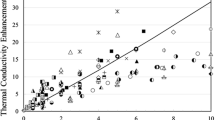Abstract
The word “wire” in the sentence in my paper, “The temperature of the wire is not affected by this discontinuity,” should be replaced by “fluid.” Although Assael and Wakeham reject my suggestion that the temperature dependence of the heat transfer coefficient at the hot wire–nanofluid interface can have a significant effect on the resulting value of the thermal conductivity of the nanofluid, the results of any study in which this effect is ignored should be treated with caution. Although Tertsinidou et al. published a correction of their paper, in which, as I pointed out, the values of the mass fractions of the particles were in error, they provided no explanation for why these were in error and did not describe how the corrected values were obtained. Also, because Tertsinidou et al. did not provide the values of the thermal conductivity of the particles in their calculation the thermal conductivity of the nanofluid by the theory of Hamilton and Crosser is another reason for their findings to be treated with a great deal of caution. But even if they were correct, their findings are valid only for the hot-wire method in in which the fluid is stationary, for which the rate of heat transfer as a function of degree of turbulence is a minimum. With increasing degree of turbulence, the rate of heat transfer will increase, with the thermal conductivity of the nanofluid playing an increasingly smaller and the heat transfer coefficient at the solid-nanofluid interfaces playing a increasingly larger role. For that reason, studies of the heat transfer characteristics of nanofluids for heat exchanger purposes should rely on methods, which closely resemble the conditions of turbulent flow encountered in practice.
Similar content being viewed by others
Notes
After my paper [1] was published, someone sent me an e-mail message that he/she used the density of the powder to calculate the mass fractions, because “that is the only value I have.” I suggested that for dense particles, an approximate measure of the empty space between the particles be determined by measuring the amount of fluid required to fill it. There may be well other more precise methods for doing so.
References
D.P.H. Hasselman, Int. J. Thermophys. 39, 109 (2018)
G.J. Tertsinidou, C. Tsolakidou, M. Pantzali, M.J. Assael, L. Colla, L. Fidele, S. Bobbo, W.A. Wakeham, J. Chem. Eng. Data 62, 491 (2017)
Y. Benveniste, T. Miloh, Int. J. Eng. Sci. 24, 153 (1986)
X. Wang, X. Wu, S.U.S. Choi, J. Thermophys. Heat Transf. 13, 474 (1999)
H.Q. Xie, J.C. Wang, T.G. Xi, Y. Liu, Q.R. Wu, J. Appl. Phys. 91, 4568 (2002)
C.H. Chon, K.D. Kihm, S.P. Lee, S.U.S. Choi, Appl. Phys. Lett. 87, 153107 (2005)
C.H. Li, G.P. Peterson, J. Appl. Phys. 101, 044312 (2007)
L. Xue, P. Keblinski, S.R. Philpot, S.U.S. Choi, J.A. Eastman, J. Chem. Phys. 118, 337 (2003)
D.P.H. Hasselman, L.F. Johnson, J. Compos. Mater. 21, 508 (1987)
Y. Benveniste, J. Appl. Phys. 61, 2840 (1987)
Y.C. Chiew, E.D. Glandt, Chem. Eng. Sci. 42, 2677 (1987)
C.W. Nan, R. Barringer, D.R. Clarke, H. Gleiter, J. Appl. Phys. 81, 6692 (1997)
J.C. Maxwell, A Treatise on Electricity and Magnetism, 2nd edn. (Clarendon Press, Oxford, 1881)
R.L. Hamilton, O.K. Crosser, Ind. Eng. Chem. Fundam. 1, 187 (1962)
G.J. Tertsinidou, C. Tsolakidou, M. Pantzali, M.J. Assael, L. Colla, L. Fidele, S. Bobbo, W.A. Wakeham, J. Chem. Eng. Data 63, 4277 (2018)
Author information
Authors and Affiliations
Corresponding author
Ethics declarations
Conflict of interest
The author declared that he has no competing financial interest.
Additional information
Publisher’s Note
Springer Nature remains neutral with regard to jurisdictional claims in published maps and institutional affiliations.
Rights and permissions
About this article
Cite this article
Hasselman, D.P.H. Response to Comments by M. J. Assael and W. A. Wakeham on: D. P. H. Hasselman, “Can the Temperature Dependence of the Heat Transfer Coefficient of the Wire–Nanofluid Interface Explain the ‘Anomalous’ Thermal Conductivity of Nanofluids Measured by the Hot-Wire Method?”. Int J Thermophys 40, 60 (2019). https://doi.org/10.1007/s10765-019-2519-z
Received:
Accepted:
Published:
DOI: https://doi.org/10.1007/s10765-019-2519-z




